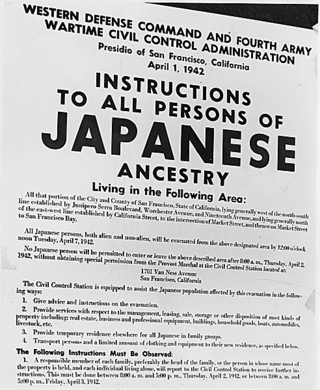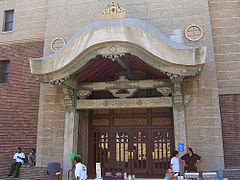
Manzanar is the site of one of ten American concentration camps, where more than 120,000 Japanese Americans were incarcerated during World War II from March 1942 to November 1945. Although it had over 10,000 inmates at its peak, it was one of the smaller internment camps. It is located at the foot of the Sierra Nevada mountains in California's Owens Valley, between the towns of Lone Pine to the south and Independence to the north, approximately 230 miles (370 km) north of Los Angeles. Manzanar means "apple orchard" in Spanish. The Manzanar National Historic Site, which preserves and interprets the legacy of Japanese American incarceration in the United States, was identified by the United States National Park Service as the best-preserved of the ten former camp sites.
Lawrence Keith "Kip" Fulbeck is an American artist, spoken word performer, filmmaker and author. Fulbeck's work explores identity politics.

Glen Shigeru Fukushima is a third-generation American of Japanese ancestry who has worked in academia, journalism, law, government, business, and in the nonprofit sector. Since September 2012, he has been a senior fellow at the Center for American Progress in Washington, D.C. In April 2022, he was confirmed by the U.S. Senate to serve as vice chairman of the Securities Investor Protection Corporation following his appointment by President Joe Biden.

Nisei Week is an annual festival celebrating Japanese American (JA) culture and history in Little Tokyo, Los Angeles. Nisei means 2nd generation in Japanese, describing the first American born Japanese, a group which the seven-day festival was originally meant to attract. Though named for the Nisei generation, Nisei Week is no longer targeted at Niseis, nor is the festival still contained within a week. Nisei Week Foundation president for 2006, Michelle Suzuki, described the festival as "the opportunity for people of all backgrounds to celebrate Japanese heritage and culture".

Clement Hanami is a Japanese-American artist. He grew up in the predominantly Latino California suburb of East Los Angeles, just outside of downtown. His mother was a hibakusha, or atomic bomb survivor. His father was a World War II incarceree.

The Grateful Crane Ensemble is a non-profit 501(c)(3) Asian American theatre company based in Southern California, established in July 2001.

Miné Okubo was an American artist and writer. She is best known for her book Citizen 13660, a collection of 198 drawings and accompanying text chronicling her experiences in Japanese American internment camps during World War II.

The Hapa Project is a multiracial identity art project created by American artist Kip Fulbeck. The project embodies a range of media, including a published book, traveling photographic exhibition, satellite community presentations, and online communities.
Nisei is a Japanese-language term used in countries in North America and South America to specify the ethnically Japanese children born in the new country to Japanese-born immigrants. The Nisei are considered the second generation and the grandchildren of the Japanese-born immigrants are called Sansei, or third generation. Though nisei means "second-generation immigrant", it often refers to the children of the initial diaspora, occurring in the late 19th and early 20th centuries, and overlapping with the G.I. and silent generations.
Robert Akira Nakamura is a filmmaker and teacher, sometimes referred to as "the Godfather of Asian American media." In 1970 he cofounded Visual Communications (VC) the oldest community-based Asian Pacific American media arts organization in the United States.
Soji Kashiwagi is a Sansei journalist, playwright and producer. He is the Executive Producer for the Grateful Crane Ensemble theatre company in Los Angeles. He has contributed to The Rafu Shimpo with his column, "Corner Store." He is the son of Nisei playwright Hiroshi Kashiwagi.

The Day of Remembrance is a day of commemoration for the incarceration of Japanese Americans during World War II. It is a day for people of Japanese descent in the U.S. to reflect upon the consequences of Executive Order 9066. The Day of Remembrance also creates a space for the facilitation of dialogue and informing the public about the repercussions of such government action. Events in numerous U.S. states, especially in the West Coast, are held on or near February 19, the day in 1942 that Executive Order 9066 was signed by President Franklin D. Roosevelt, requiring internment of all Americans of Japanese ancestry. Areas where people of Japanese descent in the U.S. were forced to relocate included Arizona, Colorado, Wyoming, Utah, Arkansas, and Idaho. There are events held in each of these states as well. Events are not only relegated to the West Coast and it is widely observed in areas such as New England, Chicago, Alaska, Philadelphia, and New York.

New Worlds, New Lives: Globalization and People of Japanese Descent in the Americas and from Latin America in Japan (ISBN 978-0804744621) is a 2002 academic book edited by Lane Ryo Hirabayashi, James A. Hirabayashi, and Akemi Kikumura-Yano and published by the Stanford University Press. The volume, edited by three Japanese American anthropologists, was produced by the Japanese American National Museum's International Nikkei Research Project. The same project produced the Encyclopedia of Japanese Descendants in the Americas: An Illustrated History of the Nikkei, and the two books are companion volumes.

Estelle Ishigo, née Peck, was an American artist known for her watercolors, pencil and charcoal drawings, and sketches. During World War II she and her husband were incarcerated at the Heart Mountain Relocation Center in Wyoming. She subsequently wrote about her experiences in Lone Heart Mountain and was the subject of the Oscar winning documentary Days of Waiting: The Life & Art of Estelle Ishigo.
George Hoshida was a Japanese American artist known for his drawings made during World War II, when he was incarcerated in three US internment camps and two Justice Department camps between 1942 and 1945. Nearly 300 of his works form the George Hoshida Collection, held and displayed by the Japanese American National Museum, founded in 1992 in Los Angeles, California.
Duncan Ryūken Williams is a scholar, writer, and Soto Zen Buddhist priest who is currently professor of religion and East Asian languages and cultures at the University of Southern California. He also serves as the director of the USC Shinso Ito Center for Japanese Religions and Culture. His research focuses on Zen Buddhism, Buddhism in America, and the mixed-race Japanese (hapa) experience.
Karen L. Ishizuka is an independent writer, curator, and documentary producer. She is a third-generation Japanese American and her family was incarcerated during World War II.
Mako Nakagawa was a Japanese American educator, director of the Japanese American Cultural Heritage Program and the Rainbow Program, and influential member of the Japanese American Citizen's League.
Grace Aiko Nakamura was a Japanese American educator and the first Japanese American teacher to be hired in the Pasadena Unified School District.

















